英语教师常用英语口语(终审稿)
- 格式:docx
- 大小:114.15 KB
- 文档页数:26

英语作文万能句子TPMK standardization office【 TPMK5AB- TPMK08- TPMK2C- TPMK18】东方英语1、Nowadays,it is generally/commonly believed that..., but I wonder that...2、“如同硬币的正反面,...也有积极的一面和消极的一面。
”Like a coin has two sides, there is a positive aspect and a negative aspect to...3、“近来,...的问题已经成为人们注目的焦点。
”Currently, the issue of ...has been brought to public attention.4、“随着...的快速增长,...在日常生活中已经变得越来越重要。
”Along with the rapid growth of ...,...has become increasingly important in our daily life.5、“由汽车引起的空气和噪音污染对我们的健康造成了危害。
”Air pollution and noise pollution caused by automobiles do harm to our health.第二种考研写作功能句型?文章结尾句型1、“因此,不难得出结论...”Accordingly/Consequently/As a result,it is not difficult to draw the conclusion that...2、“综上所述,我们能得出如下结论...”From what has been discussed above, we may reasonably arrive at the conclusion that...3、“这一难题,是任何人都不可能避免的。
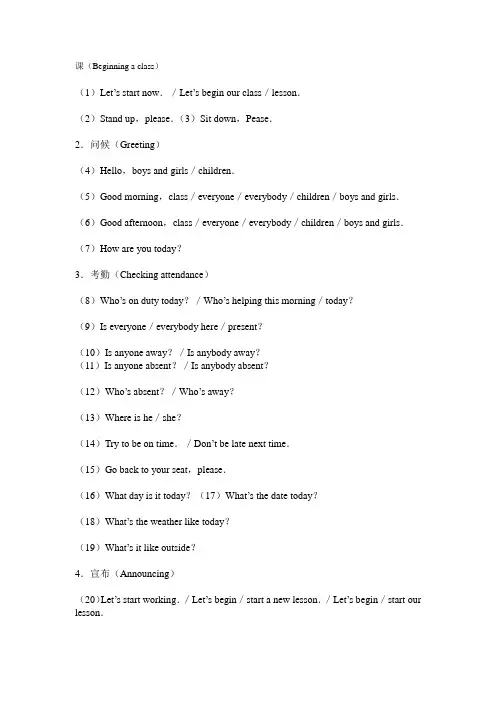
课(Beginning a class)(1)Let’s start now./Let’s begin our class/lesson.(2)Stand up,please.(3)Sit down,Pease.2.问候(Greeting)(4)Hello,boys and girls/children.(5)Good morning,class/everyone/everybody/children/boys and girls.(6)Good afternoon,class/everyone/everybody/children/boys and girls.(7)How are you today?3.考勤(Checking attendance)(8)Who’s on duty today?/Who’s helping this morning/today?(9)Is everyone/everybody here/present?(10)Is anyone away?/Is anybody away?(11)Is anyone absent?/Is anybody absent?(12)Who’s absent?/Who’s away?(13)Where is he/she?(14)Try to be on time./Don’t be late next time.(15)Go back to your seat,please.(16)What day is it today?(17)What’s the date today?(18)What’s the weather like today?(19)What’s it like outside?4.宣布(Announcing)(20)Let’s start working./Let’s begin/start a new lesson./Let’s begin/start our lesson.(21)First,let’s review/do some review.(22)What did we learn In the last lesson?(23)Who can tell/remember what we did In the last lesson/yesterday?(24)Now we’re going to do something new/different./Now let’s learn something new.(25)We have some now words/sentences.5.提起注意(Directing attention)(26)Ready?/Are you ready?(27)Did you get there?/Do you understand?(28)Is that clear?(29)Any volunteers?30)Do you know what to do?(31)Be quiet,please./Quiet,please.(32)Listen,please.(33)Listen carefully,please.(34)Listen to the tape recorder/the recording.(35)Look carefully,please.(36)Look over here.(37)Watch carefully.(38)Are your watching?(39)Please look at the black-board/picture/map…(40)Pay attention to your spelling/pronunciation.6.课堂活动(Classroom activities)(41)Start!/Start now.(42)Everybody together./All together.(43)Practise in a group./Practise In groups/In groups,please.(44)Get into groups of three/four…(45)Every body find a partner/friend.46)In pairs,please.(47)One at a time./Let’s do It one by one.(48)Now you,please./Your turn(Students name).(49)Next,please.Now you do the same,please.(50)Let’s act./Let’s act out/do the dialogue.(51)Who wants to be A?(52)Practise the dialogue,please.(53)Now Tom will be A,and the other half will be B.(54)Please take(play)the part of…(55)Whose turn is It?(56)It’s your turn. (57)Wait your turn,please.(58)Stand inline./Line up.(59)One by one./One at a time,please.(60)In twos./In pairs.(61)Don’t speak out.(62)Turn around.7.请求(Request)(63)Could you please try It again?(64)Could you please try the next one?(65)Will you please help me?8.鼓励(Encouraging)(66)Can you try?(67)Try,please.(68)Try your best./Do your best.(69)Think it over and try again.(70)Don’t be afraid/shy.9.指令(Issuing a command)(7)Say/Read after me,please.(72)Follow me,please.(73)Do what do.(7)Repeat,please./Repeat after me.(75)Once more,please./One more time,please.(7)Come here,please.(77)Please come to the front./Come up and write on the blackboard/chalkboard.(78)Come and write It on the blackboard.(79)Please go back to your seat.(80)In English,please.(81)Put your hand up,please.Raise your hand,please.(82)Put your hands down,please./Hands down,please.(83)Say it/Write it in Chinese/English.(84)Please take out your books.(85)Please open your books at page…/Find page…/Turn to Page…(86)Please answer the question/questions./Please answer my qllllst1On(s).(87)Please read this letter/word/sentence out loud./Please readout this letter /word/sentence.(88)Please stop now./Stop now,please./Stop here,please.(89)Clean up your desk/the classroom,please.(90)It’s clean-up time./Tidy up your desk/the classroom.(91)Put your things away./Clean off your desk./Pick up the scraps·(92)Clean the blackboard.(93)Plug in the tape-recorder,please.(94)Put the tape-recorder away.(95)Put the tap,In it’s box/cassette.(96)Listen and repeat.(97)Look and listen.(98)Repeat after me.(99)Follow the words.(100)Fast./Quickly!/Be quick,please.(101)Hurry!/Hurry up,please.(102)Slow down,please.(10)Slowly.(104)Bring me some chalk,please.10.禁止和警告(Prohibition and warning)(105)Stop talking./Stop talking now,please.(106)Don’t talk./Everybody quiet,please.(107)Don’t be silly.(108)Settle down.11.评价(109)Good,thank you.(10)Good/Very good./God job./Good work./Good example.(111)A good answer./Nice work.(112)Excellent./Great!/Well done./Very good./I like the way you(13)That’s Interesting(114)Don’t worry about It./No problem.(115)OK!/That’s OK.(116)I don’t think so.(117)That’s not quite right,any other answers?/That’s close/That’s almost right.(118)Not quite,can anyone help him/her?/try again.(119)A good try.12.布置作业(Setting homework)(120)For today’s homework…(121)Practise after class./Practise at home.(122)Say it out loud,before you write It down.(123)Copy/Print/Write each word twice.(124)Remember(Memorize)these words/sentences.(125)Learn these words/these sentences/this text by heart.(126)Do your homework./Do the next lesson./Do the new work.13.下课(Dismissing the class)(127)Hand in your workbooks,please.(128)Time is up.(129)The bell is ringing.(130)There’s the bell.(131)There goes the bell.(132)Let’s stop here.(133)That’s all for today.(134)Class is over.(135)Good bye./Bye./See you next time.。
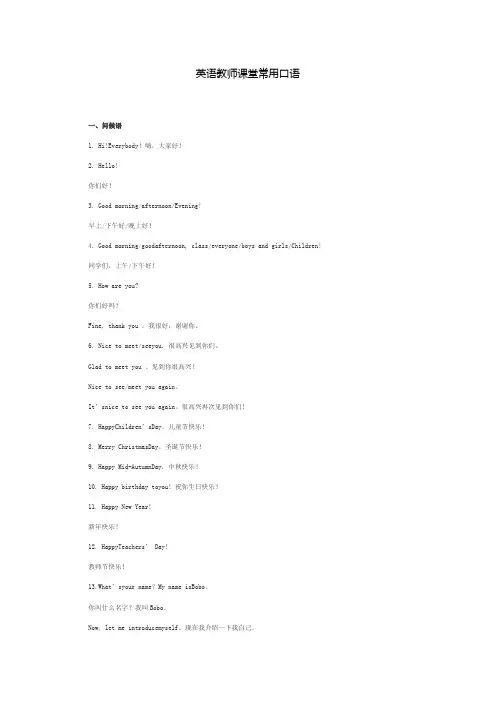
英语教师课堂常用口语一、问候语1. Hi!Everybody!嗨,大家好!2. Hello!你们好!3. Good morning/afternoon/Evening!早上/下午好/晚上好!4. Good morning/goodafternoon, class/everyone/boys and girls/Children! 同学们,上午/下午好!5. How are you?你们好吗?Fine, thank you 。
我很好,谢谢你。
6. Nice to meet/seeyou. 很高兴见到你们。
Glad to meet you 。
见到你很高兴!Nice to see/meet you again。
It’snice to see you again。
很高兴再次见到你们!7. HappyChildren’sDay。
儿童节快乐!8. Merry ChristmasDay。
圣诞节快乐!9. Happy Mid-AutumnDay. 中秋快乐!10. Happy birthday toyou! 祝你生日快乐!11. Happy New Year!新年快乐!12. HappyTeachers’ Day!教师节快乐!13.What’syour name?My name isBobo。
你叫什么名字?我叫Bobo。
Now, let me introducemyself。
现在我介绍一下我自己。
14. Are you Andy ? Yes, I am。
你是安迪吗?是的,我是。
15.Whereis Andy?I amhere。
安迪在哪里?我在这里。
16. Give me a big hug。
给我一个大大的拥抱。
17. You look so prettytoday! 你今天看上去真漂亮!18.What’s the weather liketoday? 今天天气怎么样啊?It’s sunny/rainy/cloudy/windy/snowytoday。
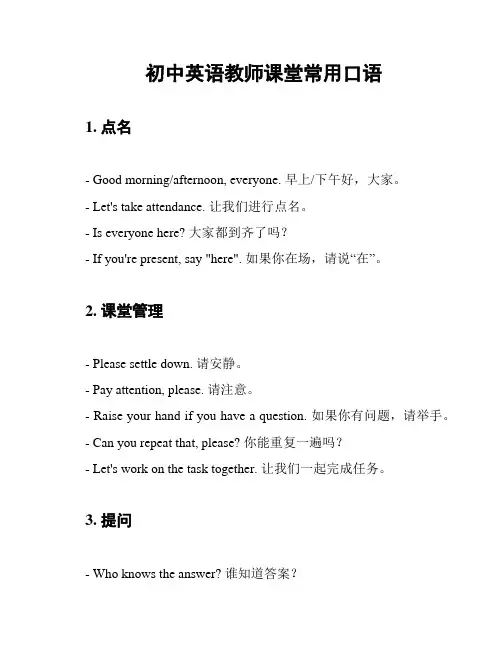
初中英语教师课堂常用口语1. 点名- Good morning/afternoon, everyone. 早上/下午好,大家。
- Let's take attendance. 让我们进行点名。
- Is everyone here? 大家都到齐了吗?- If you're present, say "here". 如果你在场,请说“在”。
2. 课堂管理- Please settle down. 请安静。
- Pay attention, please. 请注意。
- Raise your hand if you have a question. 如果你有问题,请举手。
- Can you repeat that, please? 你能重复一遍吗?- Let's work on the task together. 让我们一起完成任务。
3. 提问- Who knows the answer? 谁知道答案?- Can you give me an example? 你能给我一个例子吗?- What do you think? 你认为怎样?- Don't be afraid to make mistakes. 不要害怕犯错。
4. 鼓励和肯定- Excellent job! 做得很好!- Well done! 干得好!- You're making great progress. 你进步很大。
- I believe in you. 我相信你。
- Keep up the good work. 保持好的工作。
5. 课堂结束- Class dismissed. 下课。
- Don't forget to do your homework. 别忘了做作业。
- Have a nice day. 祝你们愉快。
以上是初中英语教师在课堂中常用的口语表达,希望能帮到你。

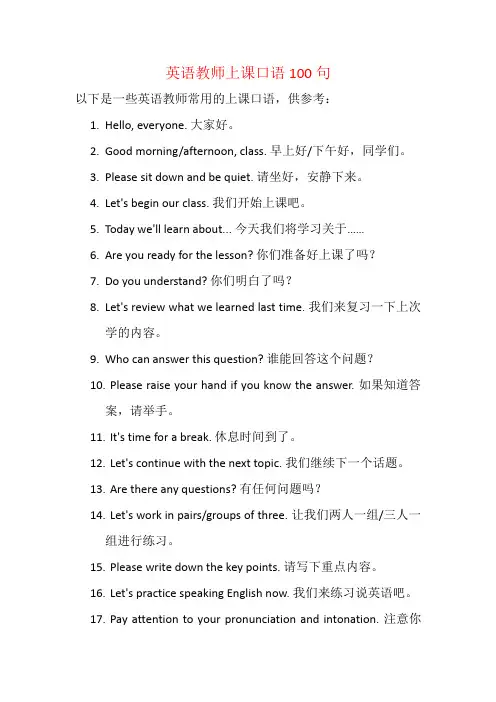
英语教师上课口语100句以下是一些英语教师常用的上课口语,供参考:1.Hello, everyone. 大家好。
2.Good morning/afternoon, class. 早上好/下午好,同学们。
3.Please sit down and be quiet. 请坐好,安静下来。
4.Let's begin our class. 我们开始上课吧。
5.Today we'll learn about... 今天我们将学习关于……6.Are you ready for the lesson? 你们准备好上课了吗?7.Do you understand? 你们明白了吗?8.Let's review what we learned last time. 我们来复习一下上次学的内容。
9.Who can answer this question? 谁能回答这个问题?10.Please raise your hand if you know the answer. 如果知道答案,请举手。
11.It's time for a break. 休息时间到了。
12.Let's continue with the next topic. 我们继续下一个话题。
13.Are there any questions? 有任何问题吗?14.Let's work in pairs/groups of three. 让我们两人一组/三人一组进行练习。
15.Please write down the key points. 请写下重点内容。
16.Let's practice speaking English now. 我们来练习说英语吧。
17.Pay attention to your pronunciation and intonation. 注意你的发音和语调。
18.Don't hesitate to ask for help if you need it. 如果需要帮助,请不要犹豫。
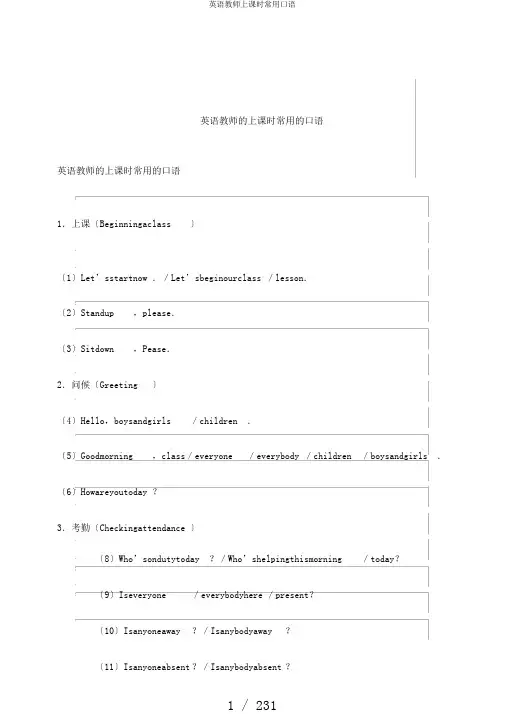
英语教师的上课时常用的口语英语教师的上课时常用的口语1.上课〔Beginningaclass 〕〔1〕Let’sstartnow./Let’sbeginourclass/lesson.〔2〕Standup ,please.〔3〕Sitdown ,Pease.2.问候〔Greeting 〕〔4〕Hello,boysandgirls /children .〔5〕Goodmorning ,class/everyone /everybody /children /boysandgirls .〔6〕Howareyoutoday ?3.考勤〔Checkingattendance 〕〔8〕Who’sondutytoday?/Who’shelpingthis morning /today?〔9〕Iseveryone /everybodyhere /present?〔10〕Isanyoneaway ?/Isanybodyaway ?〔11〕Isanyoneabsent ?/Isanybodyabsent ?12〕Who’sabsent?/Who’saway?〔13〕Whereishe /she?〔14〕Trytobeontime ./Don’tbelatenexttime.〔15〕Gobacktoyourseat ,please.〔16〕Whatdayisittoday ?〔17〕What’sthedatetoday?〔18〕What’stheweatherliketoday?〔19〕What’sitlikeoutside?5.价Good,thankyou.Good/Verygood./Godjob./Goodwork./Goodexample.Agoodanswer./Nicework.Excellent./Great!/Welldone./Verygood./IlikethewayyouThat’sInteresting!Don’tworryabou tIt./Noproblem.OK!That’snotquite right,anyotheranswers?/That’sclose/That’salmostright.4.布置作〔Settinghomework〕Fortoday’s homework⋯Practiseaft erclass./PractiseathomeSayitoutloud,beforeyouwriteItdown.Copy/Print/Writeeachwordtwice.Remember 〔Memorize〕thesewords/sentences.Learnthesew ords/thesesentences/thistextbyheart.Doyourhomew ork./Dothenextlesson./Dothenewwork.下〔Dismissingtheclass〕Handinyourworkbooks ,please.Timeisup.Thebellisringing.There’sthebell.Theregoesthebell.Let’sstophere.That’sallfor today.Classisover.Goodbye./Bye./Seeyounexttime.LiHong,haveyoucollectedalltheexercise-books?李红,作业本都收齐了吗?Hereareyourexercise-books.Pleasehandthemout.这是练习本,请发下去。

英语必背口诀公司内部档案编码:[OPPTR-OPPT28-OPPTL98-OPPNN08]英语必背口诀口诀一名词变复数一个有信仰的海湾首领叫农奴到屋顶拿手帕。
(belief,gulf,chief,serf,roof,handkerchief后接s)间里有架钢琴,钢琴上有台收音机,收音机旁有幅照片,照片里有动物园,动物园里有竹子。
(studio,piano,radio,photo,zoo,bamboo后接s)口诀二介词口诀this、that、tomorrow,yesterday,nex t、last、one。
接年、月、季、星期、周,介词省略已习惯。
over、under正上下,above、below则不然。
若与数量词连用,混合使用亦无关。
beyond超出、无、不能,against靠着,对与反。
besides,except分内外,among之内along沿。
同类比较except,加for异类记心间。
before、after表一点, ago、later表一段。
before能接完成时,ago过去极有限。
since以来during间,since时态多变换。
与之相比beside,除了last but one。
口诀三直接间接引语直引若是一般问,变间if\whether连。
语序变为陈述式,时态人称相应变。
直引若是特殊问,疑问词连接记心间。
其余问题挺简单,一切只当一般问。
直引若是祈使句,谓语动词挺要紧。
told\asked\ordered,根据口气来选定。
告诉人、请人、命令人,后跟to do sth.。
若是否定祈使句,not to do后边行。
口诀四非谓语动词非谓语动词的一些特殊用法后只接不定式作宾语的一些常用特殊谓语动词。
动词后,不定式,want,hope和wish,agree,decide,mean,manage,promise,expect,pretend,且说两位算在此,要记牢,要记住,掌握它们靠自己。
口诀五五中基本句型歌英语句万万千,五大句型把线牵。
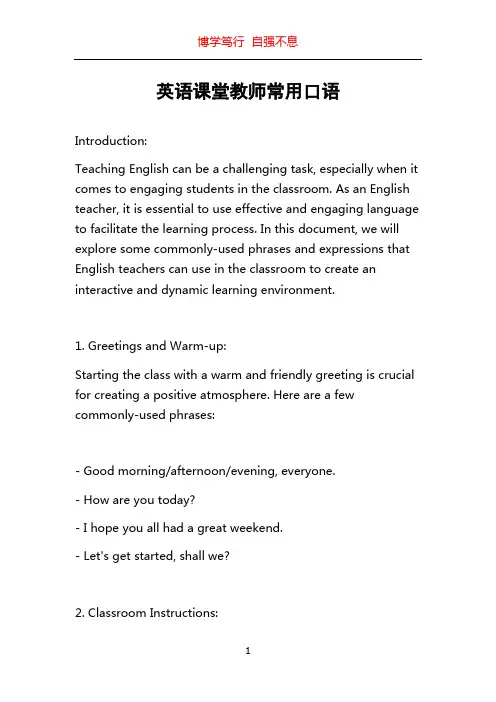
英语课堂教师常用口语Introduction:Teaching English can be a challenging task, especially when it comes to engaging students in the classroom. As an English teacher, it is essential to use effective and engaging language to facilitate the learning process. In this document, we will explore some commonly-used phrases and expressions that English teachers can use in the classroom to create an interactive and dynamic learning environment.1. Greetings and Warm-up:Starting the class with a warm and friendly greeting is crucial for creating a positive atmosphere. Here are a few commonly-used phrases:- Good morning/afternoon/evening, everyone.- How are you today?- I hope you all had a great weekend.- Let's get started, shall we?2. Classroom Instructions:Clear and concise instructions are essential for students to understand and follow directions. Here are some useful phrases for giving instructions:- Please take out your textbooks and turn to page...- Could you please pass these worksheets forward?- Let's work on this activity in pairs.- Pay attention, everyone.3. Asking and Answering Questions:Encouraging students to ask questions and providing them with the opportunity to answer is crucial for active learning. Here are some commonly-used phrases for this purpose:- Does anyone have any questions?- What are your thoughts on this topic?- Can you give an example?- Who would like to share their answer?4. Classroom Management:Maintaining discipline and order in the classroom is essential for effective teaching. Here are some phrases that teachers can use for managing the classroom:- Please settle down, everyone.- Raise your hand if you would like to speak.- Keep the noise level down, please.- Let's have one person speak at a time.5. Giving Feedback:Providing constructive feedback helps students understand their strengths and areas for improvement. Here are some phrases to use when giving feedback:- Well done! Your pronunciation is excellent.- You need to work on your grammar in this sentence.- Try to speak a bit louder next time.- I appreciate your effort and improvement.6. Explaining Difficult Concepts:Sometimes, students may struggle to understand complex concepts. Here are some phrases that can help teachers explain difficult topics:- Let me break it down for you.- It's like... (provide an analogy)- Can you give me an example to illustrate this?- Do you understand now? Is there anything that needs clarification?7. Encouragement and Motivation:Encouraging and motivating students is essential for fostering a positive learning environment. Here are some phrases that teachers can use to boost students' confidence:- I know this might be challenging, but I believe in you.- Keep up the good work!- That's a great effort. Don't give up!- You're making progress. Keep practicing!Conclusion:In conclusion, as an English teacher, effective communication is crucial for engaging students and creating an interactive learning environment. Using these commonly-used phrases in the classroom can help teachers facilitate the learning process, manage the classroom effectively, and motivate students to reach their full potential in learning English.。

小学英语课堂热身w a r m-u p文稿归稿存档编号:[KKUY-KKIO69-OTM243-OLUI129-G00I-FDQS58-Warm-up:1、One two three fourone two three four ,clap your hands (1 2 3 4,拍拍手)two two three four,stomp your feet(2 2 3 4,跺跺脚)three two three four,nod your head,(3 2 3 4,点点头)four two three four,hands on knees.(4 2 3 4,小手放到膝盖上)2、Let’s countone two ,tie your shoe(伸出手指数数,作系鞋带状)Three four ,touch the floor(伸出手指,蹲下摸地面)Five six ,stir and mix(伸出另一只手数数,作搅拌状)Nine ten ,count again(双手反过来再数一遍)One two three four five six seven eight nine ten (一只手指,一只手指的再数一遍)3、Clap stomp snap bumpclap clap clap(拍拍手)Stomp stomp stomp(跺跺脚)Snap snap snap(打响指)Bump bump bump (打击膝盖)4、Shake your body(1)shake your shoulders,shua shua shua (上下抖动肩膀)Shake your hands ,clap clap clap(甩甩手,拍三下)Shake your hip ,pia pia pia(扭扭屁股,打三下)Shake your feet ,dong dong dong(抖抖脚,跺三下)5.Shake your body(2)Shake shake up (胳膊和手全部向上摇摆)Shake shake down(胳膊和手全部向下摇摆)Shake shake shake shake(摇一摇,摇一摇)Let’s turn around(转一圈)Shake shake up (胳膊和手全部向上摇摆)Shake shake down(胳膊和手全部向下摇摆)Shake shake shake shake(摇一摇,摇一摇)Let’s sing a song(做出唱歌的样子)6、Finger playone finger ,one finger ,turn turn turn ,turn to a toothbrush ,shua shua shua(两只手各出示一只手指,变成一个牙刷的样子,在嘴边上下刷动) Two finger, two finger ,turn turn turn ,turn to a rabbit ,jump jump jump(两只手各出示两只手指,转一下,变成一个兔子的样子,上下跳)Three finger ,three finger,turn turn turn ,turn to a fork ,cha cha cha(两只手各出示三只手指,转一下,变成一个叉子的样子,上下叉动)Four finger ,four finger ,turn turn turn ,turn to a cat ,meow meow meow (两只手各出示四只手指,转一下,变成一个猫的样子,在嘴边划动)Five finger ,five finger ,turn turn turn ,turn to a tiger ,aw aw aw(两只手各出示五只手指,转一下,变成一个老虎的样子,两只手举起来假装扑向孩子)7、HelloHello ,hello ,how are you (左摆手,右摆手,双手头上打开)Fine ,fine,thank thank you(依次伸左右大拇指,拱手感谢)Hello ,hello ,how are you (左摆手,右摆手,双手头上打开)No no ,just so so(双手胸前摆手后体前交叉低头摇晃身体做不好意思状)8、Oh rabbitOh rabbit ,oh rabbit(双手做兔耳朵学兔跳两下)red red eyes(双手OK眼前晃三下)Oh shua ,oh shua ,oh shua shua shua (双手向前开合五次)Oh rabbit ,oh rabbit(同上)long long ears(双手兔耳朵往上伸三次)Oh wu ,oh wu ,oh wu wu wu(左右手交换做聆听状)Oh rabbit ,oh rabbit(同上)Short short tail(右手放臀后)Oh pia, oh pia, oh pia pia pia(轻拍屁股五下)9、WolfKnock konck knock(敲门三下)Who is it(手放耳边听)It’s mummy(捏鼻子装妈妈的声音)Open the door(双手打开门)Come in please(招手)Oh ,no(双手胸前摆手)Big bad wolf(打狼)Go out(双手推狼出去)Big bad wolf (打狼)10、daddy mummy (曲调同‘对面的女还看过来’)Daddy mummy ,look at me((左摆手,右摆手,双手OK眼前晃一下)Look at me ,good baby(双手OK眼前晃一下,依次伸左右手大拇指)Daddy mummy look at me(同上)Clap your hands, follow me(拍手,指自己)11、follow meFollow follow follow me (双手从左往右拍手四下)Hands up ,hands down(双手头上举晃腕,向下晃腕)Follow follow follow me (双手从左往右拍手四下)Stand up sit down(起立,坐下)Follow follow follow me (双手从左往右拍手四下)Let’ s turn around(转一圈)Follow follow follow me (双手从左往右拍手四下)Let’s sing a song(手拿话筒做唱歌状)Oh lei ,oh lei ,oh lei(双手头上晃两下)Go go go(左手叉腰,右手握拳上举三次,同时跺脚三下)12、one two three four fivePoint up point down (双手食指上指,下指)Show me one(双手半握拳胸前绕动后出示1)Jump up jump down(学兔上下跳)Show me two(双手半握拳胸前绕动后出示2)Look up look down(双手OK在眼前上下看)Show me three(双手半握拳胸前绕动后出示3)Stand up sit down(起立坐下)Show me four(双手半握拳胸前绕动后出示4)Hands up hands down(双手上举放下)Show me five(双手半握拳胸前绕动后出示5)One two three four five(依次出手指表示1、2、3、4、5后砍头)13、up and downUp up touch your head(单手依次上举然后摸头)Down down touch your toes (单手依次向下摸脚)Up and down (双手齐上下)Touch your hips(摸屁股)Turn around(转一圈)Touch the ground(摸地)Yeah !(双手上举欢呼)14、come onCome on ,come on(单手依次招手)Join me join me(单手依次半握拳于胸前)Let’s play a ball(左手拍球状)Let’s play a ball(右手拍球状)Ok ok (双手OK晃)Yeah ! yeah ! yeah !(双手上举欢呼)15、Nod your headNod your head ,yes yes yes(点三下头)Shake your head , no no no(摇头)Raise youe hand ,one two three(举右手伸手指示1、2、3)Put down your hand, one two three(放下右手伸手指示1、2、3)Look at me ,look at him ,chua chua chua(双手OK指自己,指任一男小朋友,前伸手三下)Look at her ,chua chua chua(指任一女小朋友)Clap your hands pia pia pia(拍手三下)Very good ,ha ha ha(双手胸前绕圈,放嘴边大笑)Two big eyes chua chua chua(双手做望远镜状前伸手三下)Two big ears wu wu wu ,wu wu wu(双手放耳边倾听)One small nose ,eng eng eng (单手指鼻子,学小猪拱三下)One little mouth , bo bo bo (指嘴,啵三下)。

英语情景对话电话TPMK standardization office【 TPMK5AB- TPMK08- TPMK2C- TPMK18】Hello (非正式的) 你好Thank you for calling (公司名). XXX speaking. How can I help you? 感谢你拨打我们的电话,我是XXX,有什么可以效劳的吗Hey Wen. It’s Huang calling. (非正式的) 温你好,我是黄Hello, this is Huang calling. 你好,我是黄Hi, it's Tony from the XXX office here. 你好,我是XXX办公室的TonyThis is XXX. 我是XXXSpeaking.Is Fred in (非正式的)Is Jackson there, please(informal)Can I talk to your sister (informal)May I speak with Mr. Green, pleaseWould the doctor be in/availableJust a sec. I'll get him. (informal)Hang on one second. (informal)Please hold and I'll put you through to his office.One moment please.All of our operators are busy at this time. Please hold for the next available person.Could you please repeat thatWould you mind spelling that for meCould you speak up a little pleaseCan you speak a little slower please. My English isn't very strong.Can you call me back I think we have a bad connection.Can you please hold for a minute I have another call.Sammy's not in. Who's this (informal)I'm sorry, Lisa's not here at the moment. Can I ask who's callingI'm afraid he's stepped out. Would you like to leave a messageHe's on lunch right now. Who's calling pleaseHe's busy right now. Can you call again laterI'll let him know you called.I'll make sure she gets the message.Yes, can you tell him his wife called, please.No, that's okay, I'll call back later.Yes, it's James from CompInc. here. When do you expect her back in the officeThanks, could you ask him to call Brian when he gets inDo you have a pen handy. I don't think he has my number.Thanks. My number is 222-3456, extension 12.Okay, I've got it all down.Let me repeat that just to make sure.Did you say 555 Charles St.You said your name was John, rightI'll make sure he gets the message.Hello. You've reached 222-6789. Please leave a detailed message after the beep. Thank you.Hi, this is Elizabeth. I'm sorry I'm not available to take your call at this time. Leave me a message andI'll get back to you as soon as I can.Thank you for calling Dr. Mindin's office. Our hours are 9am-5pm, Monday-Friday. Please call back during these hours, or leave a message after the tone. If thisis an emergency please call the hospital at 333-7896.Hey Mikako. It's Yuka. Call me! (informal)Hello, this is Ricardo calling for Luke. Could you please return my call as soon as possible. My number is 334-5689. Thank you.Hello Maxwell. This is Marina from the doctor'sWell, I guess I better get going. Talk to you soon. Thanks for calling. Bye for now.I have to let you go now.I have another call coming through. I better run. I'm afraid that's my other line.I'll talk to you again soon. Bye.商务电话英语实战宝典5.Do you have any idea when he’ll be back你知道他何时回来吗6.I have no idea(when he’ll be back.)我不知道(他何时回来)。
英语英标读音大全TPMK standardization office【 TPMK5AB- TPMK08- TPMK2C- TPMK18】英语英标读音oo音标读音将其分为以tdk结尾和非tdk结尾,所有非tdk结尾都读长音/u:/,除wool(羊毛)与以room结尾发/u/,例:bedroom,dining-room,bathroom/u:/food,mood,boot,root,shoot t/d / /flood,blood读音同but,bus 非t/d/k /u:/ moon,noon,tool,school,spoon,too,loo,fool,pool,room长音/ i:/ 和短音/ i /的读法通常情况下,元音字母在重读开音节中都发字母本身的音,所以字母e在重读开音节中发/i/,例如:此外字母组合ee,ea,ie,ei在重读音节中都可以发/i/,例如:音标[]音的发音字母字母i,y在闭音节和非重读音节中发//,例如:字母e 在非重读音节发//,例如:音标[e]音的发音规则1、常发这个元音的有:字母"e"和字母组合"ea"。
2、.字母"a"和字母组合"ai 、ay 、ei 、ie 、ue"等也可发这个音,但出现较少。
字母e 在重读开音节中发[i],在重读闭音节通常发[e],例如:字母组合ea 在重读音节中不仅可以发[i:]音,也可以发[e]的音,在什么情况下发[i:]或[e]没有特定规则需要在平时学习中分别记忆,例如:音标[]音的发音规则字母a在重读闭音节中发[],例如:音标[]音的发音字母元音字母o在重读闭音节中通常发[ ],例如:元音字母a在w,wh后也常发[],例如:音标[]音的发音规则字母组合al在大多辅音字母前都发[],例如:字母组合au,aw,or,oar,oor,ore在重读音节中发[ ],例如:字母组合ar在w后发[],例如:字母组合ou在ght前发[],例如:音标[ɑ]音的发音规则字母组合al在大多数辅音字母前发[ :],但在f或m前发[ɑ],例如:字母组合ar在w后发[:],在其它重读音节中发[ɑ],例如:元音节母a在f,n,ss,sp,st前发[ɑ],例如:音标[]音的发音字母字母o在m,n,v或th前常发[],例如:字母u在重读闭音节中常发[],例如:字母组合ou在部分单词中也发[],例如:/:/的发音1.这是个长元音,与英音中的[:]对应,不同的是要卷舌。
英语教师课堂常用语汇总(1). How to say when it’s time for class 开始上课1. Now, here we go! Today it is a little gloomy outside but I hope your mood now it as bright as the sunshine.2. In the very beginning, how about playing a game? It is called “call and response”---- Now let me call the roll3. There goes the bell. Now class begins.4. . Now it’s time for us to have class5. Let me check up on you.6. Is anybody absent today?7. Please come earlier next time.8. Now let’s begin the new lesson.9. Please open your books and turn to page 9.10. Let’s get down to some work.(2). How to say when announcing the teaching plan 告诉说声今天的上课安排1. previously, we have finished unit……so We are going to take up a new lesson today.2. Today we’ll conduct the lesson in this way.3. To begin with, I want you to look at the dialogue on page 7.4. Before we take up the new lesson, we are going to review lesson 2.5. This is the 4th period on lesson6. In this period we’ll start with the revision of the first part of the text.6. The aim of this lesson is to teach the use of “some” and “any”.7. We shall have dictation first. Pay attention to the pronunciation and your handwriting.8. If we have time, we’ll have a short quiz.9. Where did we stop/leave off last time?(3). What to say when teaching phonetics 关于语音学习1. Notice how my tongue touches my teeth.2. This is a front/central/back vowel.3. Your lips should be spread/loosely spread/rounded.4. transcribe in phonetic symbols what you have heard.5. You’d better use the falling tone here.6. We must pay attention to sentence stress/sense groups/liaisons.7. Put some feeling into your reading.8. Your should not pause in the middle of a sense group..9. You’ve read quite well except for one place…10. You’ve mispronounced the word… Now listen to me carefull y.11. Say…after me.(4). what to say when teaching new words 教授新单词1. The word can be used either as a noun or a verb.2. Can you spell the word “blackboard”?3. What does the word “…” mean?4. What does the “…” stand for in the lesson?5. What is the implied meaning of the word “…” in the context?6. Don’t confuse the phrase “be used to” with “used to”.7. Can you distinguish/tell the difference between …and…?8. Can you think of any word to replace it?9. Please tell me what part of speech the word “…”is.10. And do you know its adjective form?11. Now remember tha t the word “sheep” has the same form in the singular as in the plural.12. The phrase “look out” here has another meaning. It’s a warming which means “be careful”.13. Please make a sentence with this phrase.14. Could you give the Chinese equivalent of the phrase?15. Give a synonym and an antonym for this word.16. Do you know another English word which means the same thing? (5). What to say when teaching the text1. Now the text. The short text is selected/ adapted from a shortstory/magazine/novel etc.2. I shall tell you something about the author’s life.3. I shall give you the general idea of the text.4. We’ll read this paragraph first and then explain the difficult sentences.5. Please analyze the second sentence in paragraph 2.6. Can you paraphrase this sentence?7. Can you retell this sentence in a way easy to understand?8. I think it can be understood from the context.9. Now I’ll read the text once more. Please listen carefully.10. Don’t hesitate to ask me, if anything is not clear.11. What’s the function of the clause introduced by “that” in this complex sentence?12. These two sentences are the same in form but different in function.13. What’s your impression of the story?14. Raise your hand if you can’t follow me.15. Say something about what you have learned from(about)the hero. (6). What to say when teaching grammar1. You should have used the future tense, not the present.2. The definite article has been left out here.3. You should not have made such a serious mistake.4. The predicate verb must agree with its subject in person and number.5. Let’s not forget the sequence tense.6. Point out the subject / the predicate / the object / the adverbial, etc.7. The first letter of a proper noun must be capitalized.8. what kind of verb is “get” here?9. It’s a link verb.10. Do not be confused about the usage of the past tense and the present perfect tense.11. Please explain why the order of the sentence is inverted.12. How does a gerund differ from a present participle?13. How about changing direct speech to indirect speech?14. Your sentence is grammatically correct, but idiomatically not. It should be…15. Can you replace the attributive clause with a participle phrase?(7). What to say when doing oral work1. Now let’s do the question s and answers on the text in pairs.2. Listen carefully and see whether his answer is correct.3. Can you improve on his answer? / Can you make it better?4. Does anybody share his view?5. Now look at the pictures on page 34 and try to tell the story in your own words.6. Well, I’ll ask two students to give us a dialogue on this topic. Who will be the pair to speak?7. Use your imagination while talking about the pictures.8. Speak clearly so as to make yourself understood.9. Now we’ll have discussion. You’re supposed to say something about…10. How do you explain the idea in simple English?11. Would you like to / will you speak a bit louder?12. Certainly. / Yes, I will.13. Please speak a bit louder.(8). What to say when written exercise1. Copy them into your exercise books.2. Write sentences after the given model.3. Write a short passage using these phrases.4. what did you put for No.3?5. See if you can put the verb in the right form.6. Exchange papers with somebody nearby / your partner.7. Mark the right / wrong answer with a tick / cross.8. Give yourself one point for every correct answer.9. Which of the four choices best completes the sentence?10. C is the right choice. It fits the sentence idiomatically.11. Make sure to write them out clearly in your exercise book.12. Please hand in clear copies.13. You’ve make good progress. But there is still much room for improvement.14. You must strive to work harder, otherwise, you won’t be able to catch up with your classmates.(9). What to say when doing translation and composition work1. We’ll have translation exercises today.2. Can you translate it into English / Chinese for me?3. Translate from Chinese / English into English / Chinese.4. What’s wrong with this translation?5. Who can give a better version?6. Is the translation true to the original?7. Now let’s talk about how to write good compositions?8. You must work out an outline before writing.9. Make a draft first, then copy it into your composition books.10. Write a composition about 350 words.11. Write a composition about what you’ve learned from…(10). What to say when teaching handwriting1. Write it in block letters / in print / in italics / in capital letters / in small letters.2. Copy these words five times.3. Write on every other line.4. Your handwriting is illegible.5. Write more slowly and carefully. Don’t scribble.6. Write from memory the English alphabet.7. We start each new paragraph on a new line.8. To begin each sentence, we should capitalize the first letter of the first word.9. Don’t forget to put a full stop at the end of each sentence, or to put a question mark if it is a question.10. Make sure I can read your handwriting.11. I can’t make out your handwriting.12. Leave space between each word. I hope your exercise books will be clean and tidy.13. I’s afraid you will have to recopy it.(11). What to say when organizing blackboard activity1. Go / Come to the blackboard.2. Take a piece of chalk and write the sentence / word out.3. Write it next to / above / below that word.4. Try to keep your handwriting straight / level.5. Move out of the way so that everyone can see.6. Can you see anything wrong with sentence 4?7. Erase the last letter.8. Would you go and fetch some chalk for me, please?9. Where is the eraser / sponge / duster?10. Clean the blackboard, please.11. Leave the answers on the board. You didn’t do it well this time, did you?12. No, I didn’t. let me try again.(12). What to say when organizing role playing1. Now let’s act out this con versation / little play.2. Any volunteers? I’d like to act the part of …3. Who would like to be…? Come to the front, please.4. Mr.Wang, you play the role of …And the rest of you are audience. Any problems?5. Who would like to act the scene for us?6. try to manage without your book, please.7. Let’s rehearse first.8. Pretend that you are a teacher.9. I think we should clap.(13). What to say when teaching in the sound lab1. Now, first of all, I’d like you to get familiar with the machines you’re to u se.2. So switch the machine on.3. Could you plug the recorder in, please?4. Pull the plug out of the wall. / Unplug the recorder.5. Check whether your microphone is switched on.6. Make sure your number counter is at zero.7. Press your call button if you have any problems.8. Listen carefully to the instructions.9. while listening, mark your answer sheet.10. Hang up your headphones before you leave.11. Pull down / Roll up the screen.12. I’m going to show you some slides of English.13. Adjust the focus, please.(14). What to say when controlling the classroom1. Eyes to the front, please.2. Look at me / the backboard.3. Pay attention now. / Could I have your attention?4. May I have your attention, please?5. Try to concentrate now.6. Silence / Attention, please.7. Don’t shout / make any noise.8. Settle down, all of you.9. Don’t keep turning around.10. Stop fidgeting / messing around / playing the fool.11. Behave yourself.12. Word in twos / pairs / threes / fours, etc.13. Form into groups of three, etc.14. work on your own. / Everybody works individually.15. No cheating / peeping / whispering.(15). What to say when giving assignments or dismissing class1. Now for your homework. Please do Exercises 5 on page 41 in you exercise books.2. For today’s homework, make sentences out of the words on the blackboard.3. Learn the text by heart and do the exercises on page 20.4. Your homework today is to prepare the last two paragraphs for Monday.5. Finish this off at home.6. Hand in your exercise books tomorrow.7. I’m not going to give you any homework this time.8. We’ll leave off here today.9. class (is) dismissed.10. Let’s have a break.11. See you tomorrow / next week / on Wednesday. \12. any question? If no, just,go!。
学习英语首先学会有事情做Pleasure Group Office【T985AB-B866SYT-B182C-BS682T-STT18】学习英语,首先学会“有事情做”初学英语学什么就是要学会“有事情做”。
这是很有道理的,很多人都不愿意下岗,下岗后就是生活无着落,还是要找事情做。
英国人也好,中国人也好,都是勤劳的民族,都喜欢“有事情做”。
我们学习英语就是要把“有事情做”放在首位。
一.英语里有两个“有”。
“学会两个有,大胆会开口,存在there be, 拥有是have" (have has had)I have a book. 我有一本书。
(是本书是属于我的)He has a pen. 他有一只钢笔。
(这本书是属于他的,has是have的三单形式。
二.“事”是“是”的谐音,就是要学会使用be动词的句型。
be可以变化为:is am are was were.1. 主语+be(的适当变化形式)+名词什么是什么 This is a book。
2. 主语+be(的适当变化形式)+形容词什么人/物怎么样 It is beautiful.3. 主语+be(的适当变化形式)+副词或介词短语表示什么人/物在什么位置。
He is here. she si there.They are in the room.三.“情”就是情态动词。
“情态动词为老大,句型改变考虑它”“情态动词有词义,改变句型靠自己”I can speak English. She must go home now.May I come in We should study English hard.四. “做”代表所有行为动词.“行为动词千千万,统统都归do 来管(do does did ).Do you like EnglishDoes he like English, tooDid you study English yesterday小结:“有事情做”可以轻松地使初学者快速进行句型转换,快速开口讲话,建立信心把英语快速学好。
英语教师常用英语口语英语课堂用语1、Let’s get ready for class. 准备上课。
2、I’m sorry I’m late. /Excuse me for coming late. 对不起,我迟到了。
3、Please come earlier next time. 下次请早点到。
4、Class begins. 上课。
5、Who’s on duty today? 今天谁值日?6 、Is everyone here? 都到齐了吗?7、Who’s absent today? 今天谁没来?8、What day is today? 今天是星期几?9、What’s the date today? 今天是几号?10 Li Hong, have you collected all the exercise-books? 李红,作业本都收齐了吗?11 、Here are your exercise-books. Please hand them out. 这是练习本,请发下去。
12、 Monitor, would you please fetch some chalk for me? 班长能帮我去拿些粉笔来吗?13 Open your books, please. 请翻开书。
14 Please turn to Page 12. 请翻开书本十二页15 Please take out your notebooks/exercise books. 请拿出笔记本/练习本。
16 No more talking, please. 请安静。
17 Attention, please. 请注意。
18 Let’s have a dictation. 让我们来听写。
19 We’re going to have a new lesson today. 今天我们要上新课。
20 First let’s have a revision. 首先我们复习一下。
英语课堂教学中教师常用口语英语课堂教学是教师与学生之间最直接的交流方式,使用恰当的口语表达对于教学的有效性至关重要。
在英语课堂中,教师常常使用一些常用口语来与学生进行互动,激发学生的学习兴趣,增强学习的效果。
下面是一些英语课堂教学中教师常用的口语:1. Getting students' attention- Good morning/afternoon, class. Let's begin, shall we?- All eyes on me, please.- May I have your attention, please?- Listen up, everyone.- I need your full attention.2. Explaining instructions- This is what we're going to do today.- I will explain how to do this task.- First, I will give you the instructions.- Let me break it down for you.- Are you all clear about what to do?3. Checking understanding- Do you understand what I just said?- Shall I repeat that?- Are you following me so far?- Does everyone get it?- Any questions before we move on?4. Encouraging participation- I'd like to hear from each of you.- Don't be shy, feel free to share your ideas. - Who would like to volunteer?- Speak up, don't hesitate.- Everyone's opinion matters in this class.5. Giving feedback- Good job!- Well done!- You're on the right track.- I like how you explained your answer.- Keep up the good work.6. Asking for opinions- What do you think about this topic?- How do you feel about this issue?- Can you share your thoughts on...?- Do you agree or disagree? Why?- What is your perspective on this matter?7. Explaining difficult concepts- Let me clarify this for you.- Allow me to elaborate.- What I mean by that is...- To put it simply,...- Here's an example to help you understand better.8. Encouraging collaboration- Work together in pairs/groups.- Discuss with your partner/team.- Share your findings with the class.- Let's have a class discussion.- Help each other out.9. Time management- We have 10 minutes left.- Let's move on to the next activity.- Wrap it up, please.- Can we finish this task within the given time?- Make sure you manage your time wisely.10. Wrapping up the lesson- We've covered a lot today.- To summarize...- In conclusion...- Any final questions before we end?- Remember to review what we've learned.以上就是英语课堂教学中教师常用的口语表达。
教师英语课堂用语常用口语Hey there, all you English - learning enthusiasts! I'm a teacher, and today I'm gonna spill the beans on some super - useful English classroom expressions that we teachers often use.When starting a class, I usually say, "Good day, class! How are we all today?" It's like a warm - up for the whole learning session. You know, it's just like when you meet your friends and you ask how they're doing. It sets a friendly tone. And then I might add, "Are we ready to dive into the wonderful world of English?" This gets the students excited, or at least it should. I mean, who doesn't want to explore something wonderful?During the lesson, if a student is a bit distracted, I'll say, "Eyes on me, [student's name]." It's a simple but effective way to bring their attention back. It's like a little tug on their mental leash. If a student answers a question really well, I'll exclaim, "Fantastic job, [student's name]! You're on fire today!" This praise is like fuel for their motivation. It makes them feel good about themselves and encourages them to keep participating.When explaining grammar, I might say, "Think of verbs as theaction heroes of a sentence. They're the ones that do all the exciting stuff." This analogy helps students understand the role of verbs better. And if a student doesn't quite get it, I'll say, "Let me break it down for you. Verbs are like the engines of a car. Without them, the car - or in this case, the sentence - just won't go anywhere."When it comes to group work, I'll say, "Okay, now team up. Find a partner or two and let's get cracking on this activity." It's like starting a little adventure within the classroom. And if there's some confusion in the groups, I'll walk over and say, "What seems to be the hiccup here? Let's sort it out."If I want the whole class to repeat something after me, I'll say, "Repeat after me, everyone. 'I love learning English.'" It's a basic but important part of language learning. And when we're doing listening exercises, I'll tell them, "Listen up carefully, guys. This is like a treasure hunt for sounds and words."For pronunciation practice, I might say, "Open your mouths wide, like you're about to take a big bite of a delicious apple. Now say 'apple'." I use these kinds of vivid descriptions to help them getthe pronunciation right.If a student is having trouble answering a question, I'll encourage them by saying, "Don't worry, take your time. It's not a race. Just think it through." It's important to let them know that it's okay to struggle a bit.When it's time for a quiz or a test, I'll say, "All right, it's showtime! Let's see what you've learned." It gives a sense of excitement and a bit of pressure, but in a good way.When students make mistakes, I don't scold them. Instead, I'll say, "Good try, but there's a little oopsie here. Let's correct it together." This positive approach makes them less afraid of making mistakes in the future.In a role - play activity, I'll say, "Now, pretend you're in a real - life situation. You're in a restaurant, so act like it. What would you say?" It makes the learning more fun and practical.At the end of the class, I'll say, "Well, that's a wrap for today, class. Great job, everyone. Keep up the good work!" It's like a little pat on the back for all their efforts.My view is that these common English classroom expressionsare not just words. They're tools to create an engaging, positive, and effective learning environment. They can make the difference between a boring class and an exciting journey of learning English. So, for all the teachers out there, use these expressions to bring your English classes to life, and for students, know that these are the little nudges that are helping you on your language - learning path.。